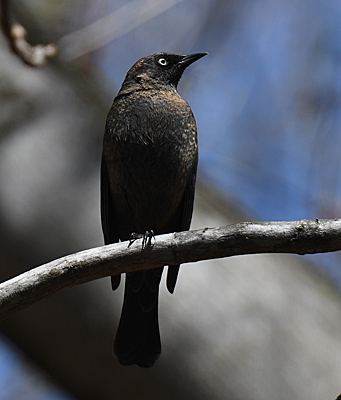JK Black Oak Wildlife Sanctuary’s diverse landscape provides habitat for many different bird species throughout the seasons. Spring and fall migration is dominated by warblers, and in the winter a few interesting flocks of sparrows can be found. During the breeding season, you can hear the Wood Thrush singing, the Pileated Woodpeckers calling, Red-tailed and Red-shouldered Hawks soaring over, and see many Gray Catbirds. Therefore, it is not surprising that we have documented 134 species at the Sanctuary over the past three years, and we expect to find more species in the future. Some of these bird species are considered a Species of Greatest Conservation Need (SGCN) in Virginia’s Wildlife Action Plan.

Rusty Blackbird
Photo by Gerco Hoogeweg
The Action Plan was written to offer strategies for rising to the challenges of the 21st century. It describes opportunities to maintain and improve our natural habitats, allowing us to conserve wildlife in ways that benefit people. For the watershed that includes the Sanctuary, the state plan identified only one to two SGCNs as being present. However, our surveys show that 19 SGCNs (for just bird species) have been found at JK Black Oak (see table below). Of these 19 species, 18 are listed in the Action Plan for the Northern Virginia planning region. This demonstrates that JK Black Oak provides a critical function in protecting many species of concern that are declining or may even be extirpated in the future.
Of the 18 bird species listed as a SGCN, 11 have been documented as breeding at JK Black Oak. Most notable are Wood Thrush, Yellow-billed Cuckoo, Yellow-breasted Chat and Gray Catbird—the unofficial mascot of the property. Five other species are known to breed in the vicinity of the Sanctuary and may forage there at times. Most exciting is the Peregrine Falcon, which is listed as a State Threatened species and breeds nearby along the Potomac River. Three species are only found during migration: the striking Black-and-White Warbler, the increasingly rare Rusty Blackbird and the stealthy Northern Harrier, a hunter of the pastures.
With more than 10 percent of the birds at JK Black Oak listed as a SGCN, it is critical to preserve this rich natural area. By increasing the habitat diversity and removing invasive species we can make the Sanctuary more attractive to current breeding birds and migrants alike. It is also important for all of us to speak up regarding development projects that could jeopardize the bird habitat necessary to the species of concern as well as other birds.
Bird species listed as Species of Greatest Conservation Need in Virginia and the Northern Virginia Planning Region.
| VA Statewide Wildlife Action Plan | Northern Virginia Planning Region
|
JK Black Oak | |||
| Species | Tier | Ranking | Tier
|
Ranking
|
Breeding Status |
| American Woodcock | III | a | Breeding | ||
| Belted Kingfisher | III | b | III | b | Visiting |
| Black-and-white Warbler | IV | a | IV | a | Migrant |
| Brown Trasher | IV | a | IV | a | Breeding |
| Chimney Swift | IV | a | IV | a | Feeding |
| Eastern Kingbird | IV | a | IV | a | Breeding |
| Peregrine Falcon* | I | a | I | a | Visiting |
| Eastern Meadowlark | IV | a | IV | a | Visiting |
| Eastern Towhee | IV | a | IV | a | Breeding |
| Eastern Wood-pewee | IV | b | IV | b | Breeding |
| Field Sparrow | IV | a | IV | a | Breeding |
| Gray Catbird | IV | a | IV | a | Breeding |
| Green Heron | IV | a | IV | a | Visiting |
| Northern Flicker | IV | b | IV | b | Breeding |
| Northern Harrier | III | a | III | a | Migrant |
| Rusty Blackbird | IV | b | IV | b | Migrant |
| Wood Thrush | IV | b | IV | b | Breeding |
| Yellow-billed Cuckoo | III | a | III | a | Breeding |
| Yellow-breasted Chat | IV | a | IV | a | Breeding |
* State Threatened
Tier III – High Conservation Need
Tier IV – Moderate Conservation Need
a – Managers have identified “on the ground” species or habitat management strategies expected to benefit the species
b – Managers have only identified research needs for the species or managers have only identified “on the ground” conservation actions that cannot be implemented
References
JK Black Oak illustrated eBird Checklist
Virginia’s 2015 Wildlife Action Plan
VWAP 18. NORTHERN VIRGINIA LOCAL ACTION PLAN SUMMARY

